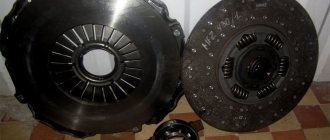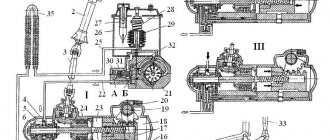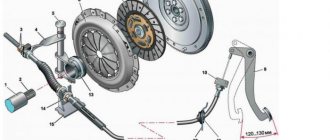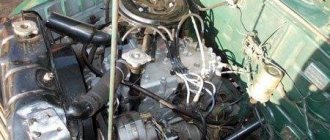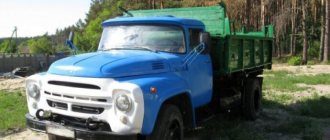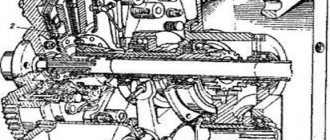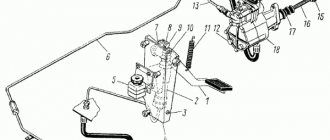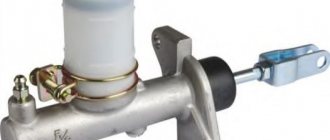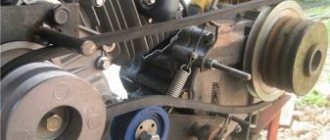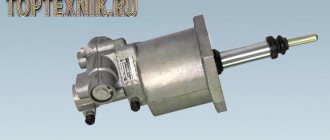The clutch is a mechanism designed to transmit engine torque to the gearbox, as well as smoothly connect and disconnect the engine with the transmission mechanisms. With its help, you can start driving a car, change gears, stop with the engine running, and maneuver during sudden changes in speed.
The clutch mechanism protects the vehicle's engine and transmission parts from damage and overload during rapid gear changes and sudden braking.
At the end of this article, watch the video tutorial , which very clearly demonstrates how the clutch mechanism in a car works.
And below we will talk about the principle of operation of the car clutch, the design and types of drives for engaging and disengaging the clutch, and how to properly use the clutch mechanism on cars with a manual transmission.
How the car clutch works
The principle of operation of a car clutch is to smoothly connect and disconnect two metal discs: one is rigidly attached to the engine shaft, and the second to the gearbox.
The clutch mechanism is activated by a cable leading from the pedal into the engine compartment of the car directly to the clutch mechanism itself. When the pedal is pressed, the engine and transmission are disconnected.
The main parts of the clutch mechanism are:
- Crankshaft flywheel;
- Drive disk (pressure);
- Driven disk.
The disk that transmits the engine force is called the drive disk (also known as the clutch disk or “basket”). It is hinged to a stamped steel casing, which in turn is rigidly bolted to the crankshaft flywheel. This type of fastening allows the clutch drive disc to change the distance to the housing.
When moving longitudinally, the clutch “basket” presses a disk called the driven . It is connected to the input shaft of the gearbox. In the working position, the driven disk is fixed between the flywheel and the pressure plate, and when the clutch pedal is pressed, it is released.
Smooth engagement of the clutch is ensured by the discs sliding until they are completely pressed against each other. To do this, the driven disk is made of several parts separated by elastic plates. It also has special linings made of material that is resistant to heat and wear. The clutch pressure plate is also spring-loaded and has heat-insulating gaskets.
When the clutch pedal is released, the driving and driven discs are pressed against the flywheel by strong springs, forming a rigid structure. In this case, the gearbox shaft begins to rotate at the same speed as the crankshaft, transmitting force to the transmission units and then through the drive shafts to the wheels. The car starts moving.
But the speeds of the two shafts cannot instantly become the same; in this case, the car will “jump” and stall. Therefore, the clutch control pedal is released smoothly in order to equalize the rotation of the drive and driven discs using friction forces. Then you can press the accelerator pedal to change the speed of rotation of the crankshaft and, accordingly, control the speed of the car.
This type of clutch is called dry, disc and permanently closed. This means that for it to work, the disc surfaces need to be dry and connected to each other when the pedal is released.
Freedom of choice: truck clutch
Selecting spare parts is simple and difficult at the same time. The abundance of brands dazzles the eye, and prices on the free market vary very significantly. Especially when it comes to expensive components. Where is the golden mean? We decided to study this issue using the example of the clutch, the unit that is most susceptible to wear in a car’s power plant.
Mikhail Ozherelyev
In commercial vehicles, where simplicity and functionality are important, and every little detail is considered from the point of view of the cost per kilometer, the share of cars equipped with manual transmissions with a conventional friction clutch is extremely high. This is kind of a classic of the genre. It is not surprising that many experts consider the friction clutch, designed to briefly disconnect the gearbox from the flywheel, one of the most conservative components of a car. Its invention is attributed to Karl Benz. However, from generation to generation, taking into account the growth in power of power units and speeds, the design of the components of this mechanism has seriously evolved: materials and technologies have changed, structural elements have become more reliable and trouble-free.
SUM OF TECHNOLOGIES
Modern trucks are mostly equipped with a dry single-plate clutch. Its design includes a flywheel, pressure and driven disks, a diaphragm spring, a clutch release bearing with a clutch and a fork. Clutches that rely on a central diaphragm spring to provide the pressure force have long been used in trucks and buses in place of the previously common coil spring design.
A significant advantage of the diaphragm spring is its nonlinear characteristic. When the pressure on such a spring changes, the force first increases, and then, having reached a certain value, begins to fall, while with cylindrical springs the force is always proportional to their compression. In addition, the clutch with peripheral springs (used, in particular, on the GAZ-53A and GAZ-24 cars) had three main disadvantages: a decrease in pressing force as the disc wears out, sensitivity to an increase in speed due to the influence of centrifugal force, and the need for more installation space .
Reverse release is the main feature of modern clutches for heavy commercial vehicles
A modern diaphragm compression spring is a high-tech product. It is a disc-shaped disk, shaped like a truncated cone. From the hole at the top of the cone there are radial slits that form petals. They perform the function of release levers. The diaphragm spring is fixed in the housing. Spacer bolts or support rings are used for fastening.
The pressure plate, diaphragm spring and housing form a single structural unit, which has a well-established name - the clutch basket. The basket has a rigid bolted connection to the flywheel. Based on the nature of the work, there are two types of clutch baskets - push and pull. In the push-action clutch basket, which is common in the passenger car segment, the petals of the diaphragm spring move towards the flywheel when the clutch is disengaged. In the clutch exhaust basket it is the other way around - the petals move away from the flywheel. This type of clutch basket is characterized by minimal thickness, therefore it is used in cramped conditions. In addition, it has a lighter casing design.
Reverse release is a key feature of modern clutches for heavy commercial vehicles. This design also has one more, apparently, main advantage: due to the advantageous position of the arm of the lever-petals of the central spring, the pull-out clutch, all other things being equal, requires the application of less squeezing force than the push force. But then the release bearing requires reliable fixation in the center of the diaphragm spring. Each clutch manufacturer has its own know-how in this regard, and this should be taken into account both when choosing repair parts and when installing them. Another assembly unit of the clutch assembly is the driven disc. It includes a torsional vibration damper, damper springs and friction washers - this set is necessary to equalize torque fluctuations that inevitably arise under the influence of variable loads and mass inertia when transmitting it from the engine to the drive wheels and back. Under some conditions, these vibrations can lead to breakage of the shafts, which means that the reliability of this device is of particular importance.
Friction linings are installed on the driven disk on both sides. The material from which they are made is very similar to that used in brake pads and previously almost always contained asbestos, but recently non-asbestos materials have been used: glass fibers, copper and brass wire, which are pressed into a mixture of resin and rubber. This composition can withstand temperatures up to 400 °C for a short time. The driven disc linings may also have a higher thermal performance.
The composition of the friction linings must withstand temperatures above 400 °C
The dimensions of the clutch are determined by the outer diameter of the driven disc, which is selected based on the requirement to transmit the maximum torque developed by the engine and dissipate the heat that appears when the clutch slips at the time of gear shifting. As for heavy trucks, 430 mm clutches are most common here. But on special and construction equipment with engines of increased power, a double-disc clutch is used, which has four friction surfaces. It transmits more torque with a smaller diameter, and also provides a longer service life of the structure. Let's note an interesting detail: European automakers use predominantly single-plate clutches in trucks. But on American trucks it’s the other way around—for special reasons, only double-disc units are used.
The cause of the breakdown may be poor quality of the part.
It is believed that the clutch is the component that is most susceptible to wear in a car equipped with a manual transmission. When a commercial vehicle is used intensively, various clutch malfunctions may occur for various reasons. These include wear and damage to the driven disk linings, its deformation, breakage or weakening of the diaphragm spring, wear or breakage of the release bearing, etc.
The clutch is the unit most susceptible to wear in the power plant
The cause of clutch failure can also be poor quality components. Car manufacturers strongly recommend that when purchasing spare parts, give preference to original components, that is, parts whose numbers are listed in the official catalog of the car manufacturer and have the designation of the corresponding car brand on the packaging and on the assembly itself, for example, Mercedes-Benz or Volkswagen. However, given the difficult economic situation, carriers are increasingly considering more budget-friendly solutions. How to avoid getting into trouble?
ANTI-CRISIS SOLUTION
An important nuance: automakers do not make the vast majority of components themselves. They order them from third-party companies, including hundreds of companies, some of which are well-known (Luk, Sachs, Kayaba, Valeo), while others are known more to specialists: Mando, Eaton, Exedy... In fact, we are talking about parts that are completely identical to those supplied to the assembly line, but sold “bypassing” the automaker and without its markings. Such components, as a rule, are significantly cheaper than “real originals”, although in essence they are also originals.
Another group of spare parts are analogues, that is, components produced by serious companies, but not supplied to the automaker’s assembly line. The cost of such analogues can be significantly lower than original products with high quality and reliability.
The best way to protect yourself from counterfeits is to work with a well-known and trustworthy store that values its reputation.
As an example, let's take the FLRS brand (owned by the Chinese company Prawolf Clutch Co., LTD). The brand specializes in the production of clutch units for commercial vehicles - trucks, buses, special equipment of Russian and foreign production (including the Big European Seven). The plant was built in 1992; a few years later, Mercedes-Benz, under a contract, equipped the production with the most modern equipment in order to produce components under its own label. Currently, FLRS products, including clutch kits and individual components, are sold on the open market. The main difference between FLRS brand spare parts and other Chinese clutch manufacturers is the materials and components used. For example, for the manufacture of a diaphragm spring, 51CrV4 steel produced by the German steel concern CDW is used. The driven disc lining is purchased from a Taiwanese manufacturer, which is the only supplier for the production of Sachs, Luk and Valeo discs in China. The torsional vibration damper springs are manufactured using 55CrSi steel, identical to Sachs products. Laser welding is also used in the process of assembling the driven disk. The company claims that this technology increases joint strength by 40% compared to riveted products. In 2014, specialists from the Research and Development Center "KAMAZ" tested clutch mechanisms with dimensions of 395 and 430 mm FLRS brand and recommended them for installation on vehicles of the KAMAZ family (the editorial office of "Avtopark" has a copy of the conclusion). In 2015, KAMAZ PJSC initiated an inspection of the production of Prawolf Clutch Co., Ltd. and concluded that cooperation with the company is possible both in the development of serial models of clutches and in the development of new products.
A few words about which components should not be chosen. If a car earns money through downtime in road repairs, then there is no point in chasing cheap little-known products and fakes may look convincing, but the low cost does not allow their “authors” to provide anything more than external similarity.
It can be difficult for a non-specialist to distinguish a fake, and the market for counterfeit spare parts is huge. There are also “left” driven disks, baskets, and release bearings, and their use often leads to repairs costing a much larger amount than the savings on parts. And the best way to protect yourself from counterfeits is to work with a well-known and trustworthy store that values its reputation.
The editors recommend:
Why do piston rings stick and how to prevent it?
A traffic police officer searched my car: did he have the right to do so?
Russians may be left without foreign cars: Western automakers have stopped supplying cars to our country
A ship that was transporting cars to Russia was detained in France
Half of the car factories in Russia have closed
News Media2
Discussion Cancel
Operating principle of clutch actuators
The principle of operation of the car's clutch drive, with which the force from the pedal is transmitted to the shift mechanism, can be mechanical, hydraulic or electric.
The mechanical clutch drive is structurally the simplest: it consists of a steel cable connecting the pedal rod and the clutch lever. There is usually a threaded connection on it, which can be used to adjust the length of the cable. The disadvantage of this drive is that it requires more force when pressing the pedal.
The hydraulic drive is more comfortable to use, especially if you have to use the clutch frequently. Its operating principle is similar to the operation of the brake system: when you press the pedal, the piston presses on the fluid, which, moving in the cylinder, sets the clutch lever pusher in motion. In this case, the pedal stroke is softer, but you need to monitor the condition of the hydraulic hoses and control the level and quality of the hydraulic fluid poured into the system.
The electric drive differs from the mechanical one in that the clutch release cable is driven by an electric motor, which is activated when the pedal is pressed. Otherwise, its design is not much different from a mechanical drive.
Clutch: why is it needed and how does it work?
Understanding the purpose of the clutch pedal, you first need to understand the operating principle of this important unit. Since the unit is considered one of the fundamental elements of the car’s chassis, it makes it possible to disconnect the crankshaft from the gearbox. It is the ability to perform this action in a short period of time that allows motorists to change gears while driving. Most modern car models have a single-plate friction clutch. That is, such a clutch device requires the presence of a main element and a drive. The clutch assembly, for a clearer understanding, consists of the following elements:
- Driven disk;
- Pressure disk;
- Release bearing;
- Pedal.
A pressure-type disk is often called a basket in everyday life. This part is directly connected to the flywheel. The driven disk is designed to help reduce the likelihood of the mechanism catching fire, and the release bearing makes it possible for the drive fork to function. Well, in fact, the clutch pedal itself in the device is designed so that the motorist can control the clutch. On cars with an automatic transmission, such a pedal is not provided.
How to use the clutch on a car correctly
In practice, working with a car’s clutch is mainly expressed in developing the skill of properly starting off, especially on an uphill slope. In busy city traffic, skillful use of the pedal will allow the car to move smoothly and not stall during sudden braking.
When starting to move, you need to release the clutch pedal, catch the moment of contact of the discs, balance the speed of their rotation, and then smoothly release the pedal. The reference point is the engine speed. If the engine runs smoothly, the clutch engages correctly.
The clutch should only be used when starting, changing gears and when stopping the vehicle. Compliance with this requirement will extend its service life.
- A sharp or, conversely, slow release of the clutch pedal at start leads to accelerated wear of the working surface of the discs.
- Stopping at a traffic light with the pedal pressed and the gear engaged will not have the best effect on the operation of the pressure springs, bearing and release fork.
The two main malfunctions of the clutch mechanism are insufficiently tight contact of the discs and insufficiently complete separation of them.
- In the first case, the clutch slips, and the car will experience poor acceleration dynamics. This is usually the result of wear on the driven disk and its friction linings.
- In the second case, as a result of incomplete separation of the disks when the gear is engaged and the pedal is pressed, the car tries to move.
If these malfunctions cannot be eliminated by adjusting the drive, then repair of the mechanism itself is necessary under stationary conditions.
How does the clutch work in robotic gearboxes?
Automatic (robot) transmissions also have a multi-plate “wet” clutch or are equipped with a “dry” clutch. Moreover, in this case, it is not the driver who presses the pedal who is responsible for turning the clutch on and off, but the servomechanism (clutch actuator).
Gear shifting on a manual transmission is also carried out using similar mechanisms. Actuators can be electric (controlled by an ECU) or hydraulic (controlled by a hydraulic distributor). In this case, as mentioned above, both an electric drive and a hydraulic drive (hydraulic clutch actuator) can be responsible for squeezing the clutch.
In the first case, the gearbox ECU, based on the readings of several sensors, determines the moment of gear shifting and sends a control signal to the clutch actuator (servo). The electric motor starts to work, disconnecting the gearbox from the internal combustion engine. Then the automation switches on the desired gear.
The hydraulic drive works in such a way that when the engine speed increases, the oil pump in the box pressurizes oil into the distributor. When the oil pressure in the distributor reaches a certain point, the oil is supplied through special oil channels and acts on the actuator.
We also recommend reading the article on how to replace the clutch on a DSG. From this article you will learn about the features of replacing a DSG clutch, as well as what needs to be taken into account as part of such a replacement.
As a result, the mechanism responsible for disengaging the clutch is activated. Then, after changing gear, the pressure is reduced, the clutch “connects” the engine to the transmission again.
At the same time, the “robot” does not always work quickly and smoothly. As a result, the driver notices a pause, and jerks and jolts may also be felt during shifts. To get rid of such shortcomings, the designers proposed a double clutch for the robot box.
In preselective dual-clutch robots (DSG type), these clutches operate alternately. When the first clutch is depressed to engage an even gear, for example, the second clutch waits to be depressed to shift to the next odd gear.
The advantages include the fact that the clutch response speed is much higher, gear shifting occurs unnoticed by the driver. The result is increased fuel efficiency, virtually no interruption in power flow at the time of switching, as well as a high level of comfort.
Wiper wiper sizes for Kia Sid/Kia Ceed 2012
Published: 02/26/2020
Spread the love
Spread the love Wipers for Kia Sid 1Contents1 Wipers for Kia Sid 11.1 Wipers for Kia Sid 21.2 Wipers for Kia Sid 31.2.1 Replacing wipers for Kia Sid/Kia Ceed Wiper blades for Kia Sid from 2006-2012 Wipers for Kia Sid 2 Wiper blades for Kia Sid from 2012-2018 Wipers for Kia Sid 3 Wiper blades for ...
Size of wipers on Kia Sid/Kia Ceed 2012 Read more »
What is clutch
A clutch is nothing more than a mechanism that uses friction to function. Due to this, it transfers rotational energy from one element of the machine transmission to another. Essentially, the unit is a friction clutch.
The unit is used to disconnect and connect the gearbox to the internal combustion engine. The first is necessary for braking or gradual stopping. The second is to transfer rotational energy to the wheels and movement. As a matter of fact, this is its main purpose.
The mechanism was invented by the German engineer Karl Benz, founder of the Daimler-Benz concern. He first used it on his wheeled Motorwagen, which was designed in 1886. The design solution showed good results and began to be used on all vehicles that were released in the future.
Honda Civic 4d lamp base
Published: 05/26/2018
Spread the love
Spread the love Honda Civic lamp socket Applicable lamps Honda Civic 4D since 2008 - HB4 halogen lamp with a power of 55 watts. L-shaped lamp with a plastic base. — HB3 halogen lamp with a power of 60 watts. L-shaped lamp with a plastic base. — H11 halogen lamp with a power of 55 watts. L-shaped lamp with a plastic base. ...
Honda Civic 4D lamp base Read more »
What is the difference between a dual-clutch transmission and an automatic and manual transmission?
Let's try to figure out what this outlandish creation of engineering is. The very concept of double clutch suggests that such a design involves the presence of two components.
That’s right, this type of clutch is distinguished by the presence of two driven friction discs, but not everything is as simple as it might seem at first glance.
The presented type of mechanism works in tandem with robotic gearboxes. In this case, we are talking about twin gearboxes, which are responsible for turning on a certain set of speeds. One is responsible for odd transmissions, the other for even ones.
Wiper wiper sizes for Hyundai Tucson 2004-2019
Published: March 10, 2020
Spread the love
Spread the love Windshield wipers for Hyundai Tucson/Hyundai Tucson Wiper blades for Hyundai Tucson 2004-2019. Which wipers are better for the Kia Karens Windshield wiper blades can be divided into three types: framed, frameless and hybrid. Hyundai Tucson comes with frame wiper blades from the factory. Frame wipers fit the windshield better and are less likely to scratch it. We recommend using...
Size of wipers for Hyundai Tucson 2004-2019 Read more »
Mechanism design
To become more familiar with the presented unit, it is necessary to study the structure of the mechanism itself, which ensures smooth gear shifting.
Unlike all other types of clutch, this type is distinguished by the presence of a number of unique components and elements.
So, this system includes the following key components:
- friction disc package;
- housing with dry or oil sump;
- mechatronics
If the first two nodes are quite familiar to car enthusiasts, then the third gives the impression of something hitherto unknown.
So, mechatronics is a high-tech clutch unit that allows you to convert electrical signals into the mechanical operation of actuator units.
Related article: Lambda probe, what is it, signs of malfunction and methods of checking
The mechatronics of a modern car, as a rule, includes two components: an electromagnetic unit and a control board.
The first is a set of solenoid valves, so-called solenoids. Previously, instead of solenoids, hydraulic distribution mechanisms, the so-called valve blocks, were used. But due to their low performance, they were replaced by more advanced electromagnetic devices.
Let's look at the fundamental features of wet and dry clutches.
"Wet" double
If we take an excursion into the history of the node in question, then the so-called “wet type” is considered to be the progenitor of the double node.
It is a set of two sections of ferodo discs immersed in an oil bath in the clutch housing.
In this case, it is customary to distinguish between two types of “wet clutch” depending on the type of vehicle drive. So, for front-wheel drive cars, a clutch with a concentric arrangement of ferodo discs is used. For owners of rear-wheel drive cars, the peculiarity of this device is manifested in the parallel arrangement of the driven disks.
This is interesting: 5 of the best car speakers for high-quality sound
The components of both types of “wet clutch” are the same. These include:
- inlet flange;
- main flange;
- drive disk;
- package of first and second order friction discs;
- diaphragm spring, auxiliary spring;
- plunger;
- hydraulic cylinders;
- input shaft of the first and second order.
"Dry" double
In addition to the “wet” clutch, there is also a so-called “dry” clutch. It cannot be said that it is worse or better than the previous one. In this case, it would be appropriate to emphasize that each of them is effectively used in the operating conditions provided for them.
Unlike the previous type, the design feature of the “dry” clutch does not require the use of lubricants. The driven disks are directly engaged with the input shafts of each gearbox.
For your information: How to make a foam generator for a car wash with your own hands
The working elements of such a mechanism include:
- input shafts;
- release bearings;
- friction discs;
- drive disk;
- two auxiliary disks;
- flywheel;
- diaphragm springs.
This design is designed to transmit less (as opposed to “wet”) torque, due to the low heat transfer coefficient.
However, due to the absence of the need to use an oil pump, which inevitably leads to power losses, the efficiency of this type of coupling is significantly superior to the previously considered variety.
Lamps used on the Renault Megane 2 car
Published: 02/11/2020
Spread the love
Spread the love Lamps on a Renault Megane 2 2002–2008 car All used Renault Megane 2 2002–2008 lamps, their characteristics and visual differences. — H7 halogen lamp with a power of 55 watts. Cylindrical in shape, with two contacts. — H1 halogen lamp with a power of 55 watts. Small, elongated size with one electrical contact. — halogen lamp H11 with a power of 55 ...
Lamps used on Renault Megane 2 Read more »
